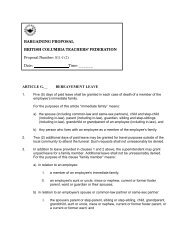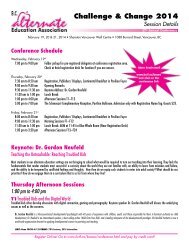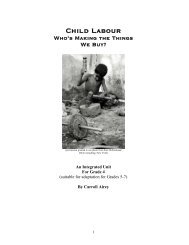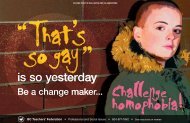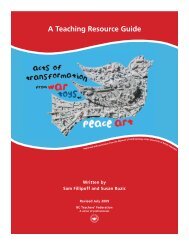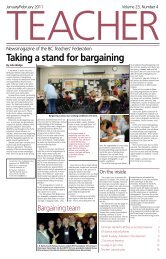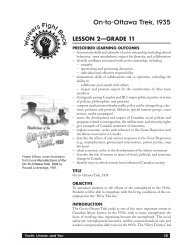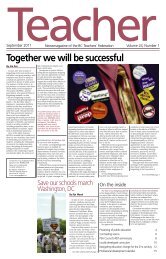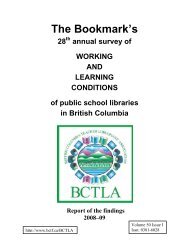Music of Cuba
Music of Cuba
Music of Cuba
You also want an ePaper? Increase the reach of your titles
YUMPU automatically turns print PDFs into web optimized ePapers that Google loves.
<strong>Music</strong> <strong>of</strong> <strong>Cuba</strong><br />
FromSon<br />
toSalsa
<strong>Music</strong> <strong>of</strong> <strong>Cuba</strong><br />
FromSon<br />
toSalsa<br />
Valerie Dare<br />
Salvador Ferreras<br />
Published by the B.C. Teachers’ Federation Lesson Aids Service
Copyright ©1997 Britannia World <strong>Music</strong> Program<br />
Materials may be reproduced for classroom use. All other uses require the permission<br />
<strong>of</strong> the author.<br />
Britannia World <strong>Music</strong> Program<br />
Britannia Secondary School<br />
1001 Cotton Drive<br />
Vancouver, BC V5L 3T4<br />
Tel: (604) 255-9371<br />
Fax: (604) 255-8593<br />
Distributed by<br />
Lesson Aids Service – B.C. Teachers’ Federation<br />
100–550 West Sixth Avenue<br />
Vancouver, BC V5Z 4P2<br />
Tel: (604) 871-2283 • 1-800-663-9163<br />
Fax: (604) 871-2295<br />
Funding for development and publication <strong>of</strong> World <strong>Music</strong> units is provided by<br />
The Vancouver Foundation.<br />
Text design and typesetting by John McLachlan
Introduction<br />
<strong>Music</strong> <strong>of</strong> <strong>Cuba</strong>; From Son to Salsa<br />
Forget sugar, rum, or cigars—<strong>Cuba</strong>’s chief export to the rest <strong>of</strong> the world is<br />
music. From salsa and jazz bands in Miami and New York to soukous and highlife<br />
dance bands in West Africa, the musical styles that began as son in <strong>Cuba</strong> have<br />
transformed popular music throughout Europe, Africa, and the Americas.<br />
The musical traditions associated with <strong>Cuba</strong> did not exist on the island five hundred<br />
years ago. The native cultures that prevailed before the Spanish conquest were decimated<br />
by the settlers who arrived in the years following a.d. 1511 and replaced by a fusion <strong>of</strong> Spanish<br />
and African traditions. With the arrival <strong>of</strong> boatloads <strong>of</strong> West African slaves over the<br />
next three hundred years, blacks made up almost half the population by the 1840s. The<br />
rhythms and dances <strong>of</strong> the Yoruba and Congolese peoples combined with the art music<br />
<strong>of</strong> Spain to produce a rich hybrid <strong>of</strong> <strong>of</strong> sensual, infectious, dance-driven styles in which<br />
African rhythms were overlaid with Latin melodic forms.<br />
Danzón, a dignified and sedate dance performed today mainly by blacks, originated<br />
from the courtly dances <strong>of</strong> Spanish colonial families. A danzón orchestra typically has cornets,<br />
clarinets, and percussion and is the most European <strong>of</strong> <strong>Cuba</strong>n musical styles.In the<br />
1930s, danzón was replaced by son as the most popular dance form.<br />
The precursor <strong>of</strong> salsa, the big band Latin jazz sound, son is still the dominant musical<br />
genre in <strong>Cuba</strong> today. The style originated in the Oriente province at the eastern end <strong>of</strong><br />
the island where thousands <strong>of</strong> Haitian refugees arrived around 1800. It fused<br />
Latin and Spanish musical elements, combining instruments such as the<br />
bongo drum, guiro (scraper), and tres (a small guitar-like lute), with the clave<br />
(wooden sticks) that play the central rhythm.<br />
Contemporary son bands like Irakere, Orquesta Reve, and<br />
NG La Banda incorporate elements <strong>of</strong> jazz and rap into<br />
their music, appealing to new generations <strong>of</strong> music lovers.<br />
<strong>Cuba</strong>n music and dances such as the bolero, cha-cha-chá,<br />
and mambo became popular overseas in the 1950s through exposure<br />
on radio, recordings, and in Hollywood movies. One <strong>of</strong> the more fascinating examples<br />
<strong>of</strong> the influence <strong>of</strong> <strong>Cuba</strong>n music on local traditions is in West Africa, where musicians<br />
combined rumba with local rhythms and guitar techniques to produce hip-shaking<br />
soukous and highlife dance styles.
Since 1990 the development <strong>of</strong> music in <strong>Cuba</strong> has been threatened by the more pressing<br />
needs <strong>of</strong> an economic crisis generated by the breakup <strong>of</strong> the Soviet Union and the U.S.<br />
embargo on vital goods and services. <strong>Cuba</strong>ns will need their indomitable spirit and strong<br />
cultural identity to sustain their nation through this period <strong>of</strong> adversity while continuing<br />
to be, in the words <strong>of</strong> the defiant slogan which defines their national character, “Everyday<br />
more <strong>Cuba</strong>n than ever.”<br />
Valerie Dare<br />
Son to <strong>Cuba</strong>n Women<br />
From all <strong>Cuba</strong>n men worthy <strong>of</strong> a<br />
<strong>Cuba</strong>n woman<br />
<strong>of</strong> noble and sound spirit and <strong>of</strong><br />
pleasant demeanour<br />
<strong>Music</strong>, sunlight, gaiety, contentment<br />
and satisfaction<br />
<strong>Cuba</strong>, its women and the son sing in my soul.<br />
Listen! Look at my joy!<br />
The cadence <strong>of</strong> my song and its sweet<br />
Inspiration<br />
Sexteto Matencero
Geographic Background<br />
BACKGROUND INFORMATION MAP<br />
STATISTICS<br />
Population<br />
Creoles, <strong>of</strong> European descent<br />
Mulattoes, <strong>of</strong> mixed African and European descent<br />
Blacks, <strong>of</strong> West African descent<br />
Spanish<br />
Chinese<br />
Other minorities<br />
RATING<br />
0 1 2 3 4 5<br />
COMPLETION ACTIVITY<br />
Map Questions<br />
DEMOGRAPHIC PIE CHART<br />
<strong>Cuba</strong>
Geographic Background<br />
BACKGROUND INFORMATION<br />
By 1570, the native Taino and Ciboney Indian population had<br />
disappeared as a result <strong>of</strong> colonization by Spain. African slaves<br />
were brought to the island over the next three hundred years to<br />
work the sugar cane fields. At the same time European settlers,<br />
mainly from Spain and the Canary Islands, brought their cultural<br />
traditions <strong>of</strong> opera, choral music, and folk music and dance<br />
to the New World.<br />
The West African slaves, especially the Yoruba and Congolese,<br />
increased the black population to 44,000 by 1774 and totalled<br />
half the population by the 1840s. Because slaves in <strong>Cuba</strong><br />
had more opportunity to buy their freedom than slaves elsewhere<br />
in the Caribbean, large communities <strong>of</strong> free blacks populated<br />
the towns. They, together with urban slaves, were permitted<br />
to celebrate their religious festivals with dance and music.<br />
Rural slaves were also allowed to sing, drum, and dance on their<br />
days <strong>of</strong>f, and many were able to leave their plantations to attend<br />
fiestas.<br />
Under these circumstances, a mix <strong>of</strong> African and European<br />
musical traditions flourished, giving rise to some <strong>of</strong> the most<br />
popular rhythms and styles in world music today, including son,<br />
rumba, mambo, and salsa. In the twentieth century, <strong>Cuba</strong>n<br />
music has influenced Caribbean and Latin American countries,<br />
West Africa, Europe, and the United States, becoming a source<br />
<strong>of</strong> inspiration for Latin jazz bands.<br />
STATISTICS<br />
Population 11,091,000<br />
Creoles, <strong>of</strong> European descent 60%<br />
Mulattoes, <strong>of</strong> mixed African and European descent 22%<br />
Blacks, <strong>of</strong> West African descent 12%<br />
Spanish 3%<br />
Chinese 1%<br />
Other minorities 1%<br />
RATING<br />
Rate the degree <strong>of</strong> multiculturalism in <strong>Cuba</strong> today.<br />
0 1 2 3 4 5<br />
low high<br />
COMPLETION ACTIVITY<br />
Use the background information to complete the following:<br />
The native Indian population in <strong>Cuba</strong> had disappeared by the<br />
year ________. They were killed by European colonizers from<br />
____________. Slaves were imported from Africa to work in<br />
the ________ ________ fields. There slaves were mainly<br />
____________ and ____________ people.<br />
S<br />
MAP<br />
Yucatan<br />
Channel<br />
Gulf<br />
<strong>of</strong><br />
Mexico<br />
HONDURAS<br />
NICARAGUA<br />
FLORIDA<br />
Miami<br />
Straits <strong>of</strong><br />
Florida<br />
Havana<br />
Grand Cayman<br />
George Town<br />
Nassau<br />
Map Questions<br />
◆ What part <strong>of</strong> the United States is closest to<br />
<strong>Cuba</strong>?<br />
◆ Which two Central American countries are<br />
closest to <strong>Cuba</strong>?<br />
◆ What language would you expect to be used for<br />
most <strong>of</strong> the place names in <strong>Cuba</strong>?<br />
DEMOGRAPHIC PIE CHART<br />
JAMAICA<br />
<strong>Cuba</strong><br />
Long Island<br />
THE<br />
BAHAMAS<br />
CUBA<br />
Kingston<br />
Caribbean Sea<br />
Acklins<br />
Island<br />
◆ Graph the percentage <strong>of</strong> each racial group in<br />
<strong>Cuba</strong>.<br />
◆ Label the parts <strong>of</strong> the graph.
Socio-Political Focus<br />
DIRECTIONS<br />
Answer the questions below.<br />
1. People from which two geographic areas contributed to <strong>Cuba</strong>n music and dance?<br />
2. Name the African people who came as slaves to <strong>Cuba</strong>.<br />
3. Which musical element present in <strong>Cuba</strong>n music came from Africa, melody or rhythm?<br />
4. Which musical element did Spain contribute, melody or rhythm?<br />
5. Which <strong>Cuba</strong>n musical genres (styles) have you heard <strong>of</strong>?<br />
6. There are seven musical genres listed for <strong>Cuba</strong>. List as many Canadian musical genres as you can.<br />
7. Draw your own Venn diagram showing the sources for Canadian music, i.e. where in the world our popular music<br />
comes from.<br />
1. __________________________________________________________________________________________<br />
2. __________________________________________________________________________________________<br />
3. __________________________________________________________________________________________<br />
4. __________________________________________________________________________________________<br />
5. __________________________________________________________________________________________<br />
6. __________________________________________________________________________________________<br />
7.<br />
<strong>Cuba</strong>
Socio-Political Focus<br />
DIRECTIONS<br />
Have students use the Venn diagram below to answer the questions on the facing page.<br />
SPAIN CUBA AFRICA<br />
Folk and<br />
art music<br />
traditions<br />
Melody<br />
Danzón<br />
Son<br />
Rumba<br />
Conga<br />
Mambo<br />
Cha-cha-chá<br />
Salsa<br />
Rhythm<br />
Yoruban and<br />
Congolese<br />
traditions<br />
<strong>Cuba</strong>
Viewing Guide<br />
DIRECTIONS<br />
View #28-4 (Controversia) from the video The Americas II and answer the questions below.<br />
1. How many musicians including singers, are involved<br />
in the controversia?<br />
3. What kind <strong>of</strong> audience is at a controversia?<br />
(Put a check mark beside your choices.)<br />
❏ Men ❏ Mostly white<br />
❏ Women ❏ Mostly black<br />
❏ Children<br />
5. Controversia lyrics are improvised. What does this<br />
mean?<br />
7. What kind <strong>of</strong> song are the men singing?<br />
(Put a check mark beside your choice.)<br />
❏ Love song<br />
❏ Protest Song<br />
❏ A song contest<br />
9. EVALUATION Why do you think more white<br />
people than black people came to hear the<br />
controversia?<br />
2. Which <strong>of</strong> the following instruments do you see?<br />
(Put a check mark beside each.)<br />
❏ piano ❏ guiro<br />
❏ trumpet ❏ flute<br />
❏ xylophone ❏ congas<br />
❏ guitars ❏ shaker<br />
4. Why do you think the audience is laughing, clapping,<br />
and applauding the singers?<br />
6. Are the two singers friends or enemies?<br />
How do you know?<br />
8. Do you think the controversia a song tradition from<br />
Africa or from Spain?<br />
❏ Africa<br />
❏ Spain<br />
Give a reason for your choice.<br />
10. CHOICE Would you attend a controversia if one<br />
were performed in your neighbourhood?<br />
❏ yes<br />
❏ no<br />
11. MAKE YOUR OWN QUESTION 12. MAKE YOUR OWN QUESTION<br />
<strong>Cuba</strong>
Viewing Guide<br />
DIRECTIONS<br />
Have students view #28-4 (Controversia) from the video The Americas II and answer the questions below.<br />
1. How many musicians including singers, are involved<br />
in the controversia?<br />
There are 11 musicians and singers.<br />
3. What kind <strong>of</strong> audience is at a controversia?<br />
(Put a check mark beside your choices.)<br />
❏ ✓Men<br />
❏ ✓Mostly<br />
white<br />
❏ ✓Women<br />
❏ Mostly black<br />
❏ ✓Children<br />
5. Controversia lyrics are improvised. What does this<br />
mean?<br />
The song is made up on the spot.<br />
7. What kind <strong>of</strong> song are the men singing?<br />
(Put a check mark beside your choice.)<br />
❏ Love song<br />
❏ Protest Song<br />
❏ ✓A<br />
song contest<br />
9. EVALUATION Why do you think more white<br />
people than black people came to hear the controvesia?<br />
The tradition comes more from their culture.<br />
2. Which <strong>of</strong> the following instruments do you see?<br />
(Put a check mark beside each.)<br />
❏ ✓piano<br />
❏ ✓ guiro<br />
❏ trumpet<br />
❏ xylophone<br />
❏ ✓guitars<br />
❏ flute<br />
❏ ✓congas<br />
❏ shaker<br />
4. Why do you think the audience is laughing, clapping,<br />
and applauding the singers?<br />
They are enjoying the song and think the singers are<br />
clever.<br />
6. Are the two singers friends or enemies?<br />
They are friends.<br />
How do you know?<br />
They smile at each other and put their arms around each<br />
other’s shoulders.<br />
8. Do you think the controversia a song tradition from<br />
Africa or from Spain?<br />
❏ Africa<br />
❏ ✓Spain<br />
Give a reason for your choice.<br />
The singers look Spanish rather than African.<br />
10. CHOICE Would you attend a controversia if one<br />
were performed in your neighbourhood?<br />
❏ yes<br />
❏ no<br />
11. MAKE YOUR OWN QUESTION 12. MAKE YOUR OWN QUESTION<br />
<strong>Cuba</strong>
Listening Guide<br />
DIRECTIONS<br />
Listen to Nena, Así No Se Vale, by Orquesta Ritmo Oriental, from the recording, World Wider Your Guider, and circle<br />
the appropriate words.<br />
STYLE<br />
a capella or accompanied fast tempo or slow tempo<br />
solo or chorus simple or complex<br />
call and response always changing or repetitive<br />
melismatic or one note per syllable<br />
INSTRUMENTS<br />
gong electric guitar keyboard xylophone<br />
drum kit chirango marimba conga drums<br />
saxophone bombo bass guitar piano<br />
clave horns kena<br />
bell rattle acoustic guitar flute<br />
MY FEELINGS<br />
curious or content<br />
excited or peaceful<br />
angry or romantic<br />
happy or sad<br />
calm or energetic<br />
powerful or weak<br />
confident or confused<br />
homesick or content<br />
THE PICTURE I SEE<br />
<strong>Cuba</strong>
Listening Guide<br />
DIRECTIONS<br />
Have students listen to Nena, Así No Se Vale, by Orquesta Ritmo Oriental, from the recording, World Wider Your Guider,<br />
and circle the appropriate words.<br />
STYLE<br />
a capella or accompanied fast tempo or slow tempo<br />
solo or chorus simple or complex<br />
call and response always changing or repetitive<br />
melismatic or one note per syllable<br />
INSTRUMENTS<br />
gong electric guitar keyboard xylophone<br />
drum kit chirango marimba conga drums<br />
saxophone bombo bass guitar piano<br />
clave horns kena<br />
bell rattle acoustic guitar flute<br />
MY FEELINGS<br />
curious or content<br />
excited or peaceful<br />
angry or romantic<br />
happy or sad<br />
calm or energetic<br />
powerful or weak<br />
confident or confused<br />
homesick or content<br />
THE PICTURE I SEE<br />
<strong>Cuba</strong>
Song Writing<br />
DEFINITION MODEL SONG LYRICS<br />
WHAT IS A ?<br />
DEFINITION:<br />
DIRECTIONS THE NEW SONG<br />
Step 1: Watch the teacher<br />
make the first line.<br />
Step 2: Help the teacher<br />
make the second line.<br />
Step 3: Make a third line<br />
with the teacher’s help.<br />
Step 4: Write a fourth and fifth<br />
line yourself.<br />
<strong>Cuba</strong>
Song Writing<br />
DEFINITION MODEL SONG LYRICS<br />
WHAT IS A controversia ?<br />
DEFINITION:<br />
A controversia is an improvised song composed by a poet<br />
singer (trovador) in response to a challenge by another<br />
trovador. Often humorous and satirical, controversias follow<br />
a set format and reflect the rich oral traditions <strong>of</strong> the<br />
<strong>Cuba</strong>n people.<br />
DIRECTIONS THE NEW SONG<br />
Trovador #2 Fourth Verse (response)<br />
Step 1: Watch the teacher<br />
make the first line. 1.<br />
Step 2: Help the teacher<br />
make the second line.<br />
Step 3: Make a third line<br />
with the teacher’s help.<br />
Step 4: Write a fourth and fifth<br />
line yourself.<br />
2.<br />
3.<br />
4.<br />
5.<br />
<strong>Cuba</strong><br />
Trovador #1 First Voice (call)<br />
Come with me, my friend, let’s go hear Ejio’s band,<br />
It’s a hot party, and they say it’ll go on till dawn.<br />
My wife is so proper, she’ll stay at home.<br />
Don’t say no, let’s go party,<br />
And I’ll show you that I’m the boss in my house.<br />
Trovador #2 Second Voice (response)<br />
I won’t go there with you,<br />
Because it’s known that your wife is fearsome.<br />
If she finds out you’re planning to drink,<br />
God bless you, she won’t let you go.<br />
She won’t let you move from the plaza to the corner,<br />
Because I know she’s the boss in your house.<br />
Trovador #1 First Voice (call)<br />
You’re all wrong, you know that I’ll go by car<br />
And I’ll spend the whole night dancing.<br />
When I get a little tipsy, I even dance the guaguanco.*<br />
The dance has started, so let’s go and boogie,<br />
I’ll show you who’s the boss at my house.<br />
* a form <strong>of</strong> rumba in which couples dance to a fast tempo
Dance<br />
DIRECTIONS<br />
Find and draw the instruments used to play rumba.<br />
DESCRIPTION<br />
Rumba is a passionate dance which demonstrates important<br />
elements <strong>of</strong> the <strong>Cuba</strong>n national character: movement,<br />
spontaneity, sensuality, sexuality, love, tension, opposition,<br />
and freedom coupled with restraint. It requires both play<br />
and deliberate action. The dance appears deceptively simple.<br />
Using subtle and discrete movements, rumba may look<br />
loose and improvised, but in reality it is closely structured.<br />
The rhythms <strong>of</strong> rumba come from claves, maracas, and<br />
drums. The tempo is quick-quick-slow.<br />
ILLUSTRATION OR STEPS DIAGRAM<br />
1. Quick: From closest position, with left knee slightly<br />
bent take small step to side on left foot; transfer<br />
weight; then straighten left leg.<br />
2. Quick: With right knee slightly bent, close right<br />
foot to left foot; transfer weight and straighten leg.<br />
3,4. Slow: With left knee slightly bent, take small step<br />
forward on left foot; transfer weight and straighten<br />
leg.<br />
5. Quick: Continuing with hip motion above, take<br />
small step to side on right foot.<br />
6. Quick: Close left foot to right foot.<br />
7,8. Slow: Take small step back on flat <strong>of</strong> right foot.<br />
COSTUME AND/OR INSTRUMENTS<br />
<strong>Cuba</strong><br />
from <strong>Music</strong> <strong>of</strong> the Andes; an Introduction to the Instruments Pre and Post Conquest.
Dance<br />
DIRECTIONS<br />
Have students draw the instruments associated with rumba, or find a video (or instructor) to teach them the dance.<br />
DESCRIPTION<br />
Rumba is a passionate dance which demonstrates important<br />
elements <strong>of</strong> the <strong>Cuba</strong>n national character: movement,<br />
spontaneity, sensuality, sexuality, love, tension, opposition,<br />
and freedom coupled with restraint. It requires both play<br />
and deliberate action. The dance appears deceptively simple.<br />
Using subtle and discrete movements, rumba may look<br />
loose and improvised, but in reality it is closely structured.<br />
The rhythms <strong>of</strong> rumba come from claves, maracas, and<br />
drums. The tempo is quick-quick-slow.<br />
ILLUSTRATION OR STEPS DIAGRAM<br />
1. Quick: From closest position, with left knee slightly<br />
bent take small step to side on left foot; transfer<br />
weight; then straighten left leg.<br />
2. Quick: With right knee slightly bent, close right<br />
foot to left foot; transfer weight and straighten leg.<br />
3,4. Slow: With left knee slightly bent, take small step<br />
forward on left foot; transfer weight and straighten<br />
leg.<br />
5. Quick: Continuing with hip motion above, take<br />
small step to side on right foot.<br />
6. Quick: Close left foot to right foot.<br />
7,8. Slow: Take small step back on flat <strong>of</strong> right foot.<br />
COSTUME AND/OR INSTRUMENTS<br />
<strong>Cuba</strong>
<strong>Music</strong>al Instruments<br />
DIRECTIONS<br />
Use the cd-rom program, <strong>Music</strong>al Instruments, to research the ___________________ .<br />
NAME & CLASSIFICATION<br />
__________: membranophone idiophone chordophone aerophone<br />
ORIGINS & GEOGRAPHICAL DISTRIBUTION<br />
MATERIALS FAMILY<br />
wood<br />
metal<br />
skin<br />
bone<br />
plastic<br />
SIZE<br />
RELATED INSTRUMENTS<br />
PITCH RANGE<br />
PERFORMANCE DETAILS<br />
LOOKS LIKE<br />
<strong>Cuba</strong>
<strong>Music</strong>al Instruments<br />
DIRECTIONS<br />
Have students use the cd-rom, <strong>Music</strong>al Instruments, to research the conga drum, or other indigenous instrument.<br />
NAME & CLASSIFICATION<br />
congas: membranophone idiophone chordophone aerophone<br />
ORIGINS & GEOGRAPHICAL DISTRIBUTION<br />
■ developed in Latin America<br />
■ prototypes came from Africa<br />
MATERIALS FAMILY<br />
wood ✔<br />
metal ✔<br />
skin ✔<br />
bone<br />
plastic<br />
Percussion<br />
RELATED INSTRUMENTS<br />
Mrdunga<br />
Odaiko<br />
Ghatam<br />
Kotsuzumi<br />
Kalungu<br />
Bongos<br />
Atumpan<br />
Timbales<br />
Dzembe<br />
Darabuka<br />
Cuica<br />
Kandang<br />
SIZE<br />
23-30 cm diameter<br />
about 90 cm tall<br />
PITCH RANGE<br />
varies with hand pres.<br />
PERFORMANCE DETAILS<br />
Congas are usually played in groups <strong>of</strong> two or three drums. Very different<br />
sound colours and pitches can be achieved by striking the conga<br />
on the skin at the centre or near the rim, using either the palms or fingers.<br />
LOOKS LIKE<br />
<strong>Cuba</strong>
<strong>Music</strong>ians<br />
DIRECTIONS<br />
Design an album cover which expresses the spirit <strong>of</strong> the music played by the artist you enjoy the most.<br />
Complete the information about the music <strong>of</strong> each artist.<br />
ALBUM COVER<br />
GROUP<br />
Name: Buena Vista Social Club<br />
Rhythm Style:<br />
Instruments Played:<br />
A Song Title:<br />
Genre/Purpose for Song:<br />
GROUP<br />
Name: Jack Duncan & Shangó Ashé<br />
Rhythm Style:<br />
Instruments Played:<br />
A Song Title:<br />
Genre/Purpose for Song:<br />
GROUP<br />
Name: Celeste Mendoza<br />
Rhythm Style:<br />
Instruments Played:<br />
A Song Title:<br />
Genre/Purpose for Song:<br />
GROUP<br />
Name: Ricardo Lemvo & Makina Loca<br />
Rhythm Style:<br />
Instruments Played:<br />
A Song Title:<br />
Genre/Purpose for Song:<br />
<strong>Cuba</strong>
<strong>Music</strong>ians<br />
DIRECTIONS<br />
Have students listen to each <strong>of</strong> the following artists and groups, choose one, and design an album cover which expresses<br />
the spirit <strong>of</strong> their music.<br />
ALBUM COVER<br />
GROUP<br />
Name: Buena Vista Social Club<br />
Rhythm Style: Son<br />
Instruments Played: guitar bass<br />
maracas bongos<br />
trumpet<br />
udu drum<br />
congas<br />
A Song Title: Chan Chan*<br />
Genre/Purpose for Song:Dance<br />
* from Buena Vista Social Club<br />
GROUP<br />
Name: Jack Duncan & Shangó Ashé<br />
Rhythm Style: Unknown<br />
Instruments Played: batá (Ilya)<br />
batá (Itotele)<br />
batá (Okonkolo)<br />
A Song Title: Orunla*<br />
Genre/Purpose for Song:Ritual<br />
* from Shangó Ashé<br />
<strong>Cuba</strong><br />
GROUP<br />
Name: Celeste Mendoza<br />
Rhythm Style: Rumba<br />
Instruments Played: congas<br />
guiro<br />
keyboard<br />
bells<br />
horns<br />
clave<br />
A Song Title: Mi Rumba Echando*<br />
Genre/Purpose for Song: Dance<br />
* from <strong>Cuba</strong> Classics 2; Dancing with the Enemy<br />
GROUP<br />
Name: Ricardo Lemvo & Makina Loca<br />
Rhythm Style: Cha-Cha-Chá<br />
Instruments Played: bass congas<br />
drum set bongo<br />
trumpet<br />
saxophone<br />
keyboard<br />
A Song Title: La Milonga de Ricardo en<br />
Cha-Cha-Chá*<br />
Genre/Purpose for Song: Dance<br />
* from Tata Masambo
Religion<br />
<strong>Cuba</strong><br />
DIRECTIONS<br />
Use the text on the opposite page to make notes in point form on each <strong>of</strong> the topics listed. Notes on Religion are done<br />
for you as an example.<br />
RELIGION<br />
Santería<br />
■ Yoruba elements and Catholic elements<br />
• similarity between deities and saints<br />
• Changó = Saint Barbara<br />
• Ogún = Saint Peter<br />
■ Orishas are gods associated with:<br />
• colours<br />
• myths<br />
• herbs<br />
• dances<br />
• songs<br />
■ Ceremonial worship<br />
• music, dance<br />
• spirit possession<br />
EXAMPLE<br />
Santa Barbara<br />
Long live Changó!<br />
Long live Changó, gentlemen!<br />
Blessed Santa Barbara,<br />
My life springs forth<br />
Inspired with emotion,<br />
in front <strong>of</strong> your beautiful image.<br />
Long live Changó!<br />
Long live Changó, gentlemen!<br />
Celina Gonzáles<br />
HISTORY<br />
■ Arrival<br />
■ 1933<br />
■ Today<br />
FOCUS<br />
Toque de Santo<br />
■ Occasion<br />
■ First Part<br />
■ Second Part
Religion<br />
DIRECTIONS<br />
Have students use the text below to make notes in point form on the student activity sheet on the facing page.<br />
RELIGION<br />
The <strong>Cuba</strong>n religion which fuses elements <strong>of</strong> Yoruba and<br />
Catholic beliefs and practices is called santería. In<br />
santería,West African deities are retained but they are<br />
identified with Catholic saints. For example, Changó, the<br />
thunder god, is linked with Saint Barbara and Ogun, the<br />
god <strong>of</strong> iron, with Saint Peter. Each god, or orisha, is associated<br />
with certain colours, myths, herbs, dances, and songs.<br />
Worship is centred in ceremonies where participants sing,<br />
dance, and sometimes enter a trancelike state in which<br />
they undergo posession by orishas.<br />
EXAMPLE<br />
Santa Barbara<br />
Long live Changó!<br />
Long live Changó, gentlemen!<br />
Blessed Santa Barbara,<br />
My life springs forth<br />
Inspired with emotion,<br />
in front <strong>of</strong> your beautiful image.<br />
Long live Changó!<br />
Long live Changó, gentlmen!<br />
Celina Gonzáles<br />
<strong>Cuba</strong><br />
FOCUS<br />
Toque de Santo<br />
A toque usually takes place at the home <strong>of</strong> a santería practitioner.<br />
The occasion may be the anniversary <strong>of</strong> some<br />
one’s initiation into santería, an orisha’s sacred day, or an<br />
honouring <strong>of</strong> the spirits in thanks for or anticipation <strong>of</strong> the<br />
granting <strong>of</strong> a favour. The first part <strong>of</strong> the ceremony starts<br />
in the afternoon when the musicians play a sequence <strong>of</strong><br />
drum patterns using batá (hourglass) drums. Each drum<br />
pattern is associated with a particular orisha and reflects the<br />
West African tradition <strong>of</strong> “talking drums” in which the<br />
drums communicate the words <strong>of</strong> praise songs.<br />
In the second part <strong>of</strong> the ceremony, a lead vocalist urges<br />
participants to sing and dance in order to persuade the<br />
orishas to descend and possess the appropriate person.<br />
The possessed individual is led away into another room,<br />
dressed in traditional garments, and <strong>of</strong>ten asked for advice<br />
or blessings.<br />
HISTORY<br />
Santería arrived with the Yoruba slaves from West Africa in the 16th century and eventually gained acceptance from<br />
the Spanish colonial rulers. Since the mid-20th century, santería has been practiced in Latino communities in North<br />
America, especially in Miami and New York. In 1993, the U.S. Supreme Court legalized animal sacrifices practiced by a<br />
santería temple in Florida. Another indication that santería is gaining acceptance is the growing number <strong>of</strong> people attracted<br />
to the religion since the arrival in North America <strong>of</strong> skilled <strong>Cuba</strong>n musicians.
Folk Tale page 1<br />
DIRECTIONS<br />
Read The Bossy Galllito and complete the activity sheets.<br />
TITLE<br />
CHARACTERS VOCABULARY<br />
The main characters are:<br />
The hero <strong>of</strong> the story is:<br />
The villain <strong>of</strong> the story is:<br />
New words I learned are:<br />
means<br />
means<br />
means<br />
means<br />
means<br />
means<br />
means<br />
<strong>Cuba</strong>
Folk Tale page 1<br />
DIRECTIONS<br />
Read the story The Bossy Gallito and complete the activity sheets.<br />
Note: This folk tale has no reference to a musical instrument but, since <strong>Cuba</strong>n tales are so difficult to find, the story is<br />
included here (besides, we can assume there will be plenty <strong>of</strong> music and dancing at the wedding!).<br />
TITLE<br />
The Bossy Gallito<br />
CHARACTERS VOCABULARY<br />
The main characters are:<br />
Gallito, a bossy little rooster<br />
Uncle Parrot<br />
Sun<br />
The hero <strong>of</strong> the story is:<br />
Gallito<br />
The villain <strong>of</strong> the story is:<br />
New words I learned are:<br />
!<br />
gallito means rooster<br />
mandón means bossy<br />
perico means parrot<br />
Tio means Uncle<br />
pico means beak<br />
el sol means the sun<br />
con gran placer! means with great pleasure!<br />
<strong>Cuba</strong>
Folk Tale page 2<br />
SETTING<br />
The physical setting for the story looks like:<br />
THEME<br />
The central idea <strong>of</strong> the story is:<br />
PLOT<br />
Introduction<br />
Rising Action<br />
Climax<br />
<strong>Cuba</strong><br />
Conclusion
Folk Tale page 2<br />
SETTING<br />
The physical setting for the story looks like:<br />
THEME<br />
The central idea <strong>of</strong> the story is:<br />
If you do somebody a favour, in time it will be returned to you.<br />
PLOT<br />
Introduction<br />
• The little gallito is<br />
going to his<br />
uncle’s wedding.<br />
• He sees two<br />
kernels <strong>of</strong> corn he<br />
wants to eat.<br />
• The corn is near a<br />
mud puddle.<br />
Rising Action<br />
• The little gallito asks the grass to help<br />
him, but the grass won’t.<br />
• He asks a goat, a stick, fire, and a<br />
stream to help him, but they all refuse.<br />
• He asks the sun to help him.<br />
Climax<br />
• The sun<br />
agrees to<br />
help.<br />
• To save themselves, the<br />
goat, stick, fire and<br />
stream <strong>of</strong>fer to help.<br />
• The little gallito gets to<br />
the wedding on time.<br />
<strong>Cuba</strong><br />
Conclusion
Glossary <strong>of</strong> Terms<br />
DIRECTIONS<br />
Write the meaning <strong>of</strong> each <strong>of</strong> the following words. Draw a picture or write a sentence which shows the meaning <strong>of</strong><br />
the word.<br />
WORD<br />
Changó<br />
Clave<br />
Conga<br />
Controversia<br />
Orishas<br />
Rumba<br />
Santeriá<br />
Son<br />
Toque<br />
Trovador<br />
Yoruba<br />
MEANING SENTENCE OR ILLUSTRATION<br />
<strong>Cuba</strong>
Glossary <strong>of</strong> Terms<br />
DIRECTIONS<br />
Have students complete either word, meaning, sentence, or illustration for the following terms.<br />
WORD MEANING SENTENCE OR ILLUSTRATION<br />
Changó<br />
Clave<br />
Conga<br />
Controversia<br />
Orishas<br />
Rumba<br />
Santería<br />
Son<br />
Toque<br />
Trovador<br />
Yoruba<br />
Thunder god<br />
rhythm instrument made<br />
from 2 wooden sticks<br />
barrel-shaped drum<br />
song form in which two<br />
singers improvise to a set<br />
pattern<br />
African gods<br />
a popular dance form<br />
a religion combining<br />
African and Catholic<br />
beliefs<br />
musical genre popular<br />
until the 1950s<br />
Santería celebration held<br />
in a house<br />
Controversia poet-singer<br />
a people from West<br />
Africa; came to <strong>Cuba</strong> as<br />
slaves<br />
<strong>Cuba</strong>
Instrument Building<br />
MATERIALS<br />
1" hardwood dowels, 8" to 10" long.<br />
DIRECTIONS<br />
1. Cut the dowels into two equal lengths.<br />
2. Sand the edges round.<br />
3. Decorate, if desired.<br />
4. Rest the dowling on your clenched fist (see illus. below). Your cupped fist will act as a sounding board.<br />
5. Tap the dowling with the other piece in a rhythmic pattern.<br />
Typical rhythmic patterns in Latin music look like this:<br />
ILLUSTRATION<br />
Three–two “clave”<br />
Two–three “clave”<br />
1+2+3+4+5+6+7+8+<br />
X X X X X<br />
q . q . q q q<br />
1+2+3+4+5+6+7+8+<br />
X X X X X<br />
q q q . q . q<br />
<strong>Cuba</strong>
Performance/Workshop<br />
RESOURCE PEOPLE<br />
Name: Salvador Ferreras<br />
Contact Information: #13–4771 Garry Street<br />
Richmond, bc v7e 2j9<br />
Tel (604) 241-4152 / Fax (604) 241-2319<br />
Audience Participants: Suitable for students in grades 8-12<br />
PERFORMANCE/WORKSHOP DESCRIPTION<br />
The evolution <strong>of</strong> <strong>Cuba</strong>n <strong>Music</strong>.<br />
Focus: Mr. Ferreras traces the development <strong>of</strong> <strong>Cuba</strong>n music from danzón and rumba to son, using recorded<br />
examples. He also demonstrates <strong>Cuba</strong>n rhythms on conga drums.<br />
STAGING REQUIREMENTS<br />
No special arrangements are needed. A<br />
classroom setting is recommended.<br />
LEARNING RESOURCES<br />
Conga drums<br />
CD and cassette player<br />
PRE-PERFORMANCE SUGGESTIONS<br />
Introduce students to the prehistory and colonization <strong>of</strong> <strong>Cuba</strong>.<br />
Stage Diagram<br />
<strong>Cuba</strong><br />
POST-PERFORMANCE SUGGESTIONS<br />
Examine the influence <strong>of</strong> <strong>Cuba</strong>n music on contemporary popular music in the Caribbean, the United States, and West Africa.
THE KNOWLEDGE FRAMEWORK (adapted from B. Mohan, 1986)<br />
CLASSIFICATION/CONCEPTS<br />
PRINCIPLES<br />
The Knowledge Framework <strong>Cuba</strong><br />
EVALUATION<br />
Thinking Process: rating, ranking,<br />
empathizing,<br />
appreciating<br />
Thinking Process: inferring, recognizing<br />
connections, understanding<br />
cause and effect,<br />
explaining<br />
Language: as a result, because <strong>of</strong><br />
Thinking Process: defining, explaining,<br />
classifying<br />
Language: I think, I felt,<br />
I understand<br />
Language: proper and generic<br />
nouns<br />
Focus: evaluate musical genres,<br />
rate <strong>Cuba</strong> as a multicultural<br />
country,<br />
guided listening<br />
Focus: fusion <strong>of</strong> African rhythms<br />
and Spanish melodic<br />
forms, controversia,<br />
religion, instruments,<br />
viewing<br />
Key Visual: Venn diagram, pie graph,<br />
map<br />
Focus: musical styles: rumba,<br />
controversia, santorías,<br />
religious practices,<br />
instruments<br />
Key Visual: rating scale<br />
Key Visual: Venn diagram<br />
K<br />
N<br />
O<br />
W<br />
L<br />
E<br />
D<br />
G<br />
E<br />
B<br />
A<br />
C<br />
K<br />
G<br />
R<br />
O<br />
U<br />
N<br />
D<br />
Thinking Process: problem solving,<br />
making decisions,<br />
drawing conclusions<br />
Thinking Process: sequencing,<br />
following instructions<br />
Thinking Process: describing,<br />
labelling, observing,<br />
listening<br />
Language: prefer, could, would,<br />
should<br />
Language: first, second, next,<br />
then<br />
Focus: rumba, dance,<br />
instrument building<br />
Language: adjectives for sound,<br />
quality, name <strong>of</strong> instruments,<br />
dances, musical genre<br />
Focus: guided listening,<br />
representative instruments<br />
A<br />
C<br />
T<br />
I<br />
O<br />
N<br />
Focus: controversia song,<br />
musicians, instruments<br />
Key Visual: album cover<br />
Key Visual: numbered instructions<br />
for dance, instrument<br />
building<br />
Key Visual: drawing for folk tale<br />
S<br />
I<br />
T<br />
U<br />
A<br />
T<br />
I<br />
O<br />
N<br />
CHOICE<br />
SEQUENCE<br />
DESCRIPTION
Reference Sources<br />
BOOKS<br />
Daniel, Yvonne. Rumba; Dance and Social Change in Contemporary <strong>Cuba</strong>, Bloomington: Indiana University Press, ©1995.<br />
González, Lucia M. The Bossy Gallito.* New York: Scholastic Inc., ©1994.<br />
Manuel, Peter, Kenneth Bilby and Michael Largey. Caribbean Currents: Caribbean <strong>Music</strong> from Rumba to Reggae.<br />
Philadelphia: Temple University Press, ©1995.<br />
Sheehan, Sean. <strong>Cuba</strong> (Cultures <strong>of</strong> the World), New York: Marshall Cavendish, ©1995.<br />
Stephenson, Richard M. and Joseph Iaccarino. The Complete Book <strong>of</strong> Ballroom Dancing, New York: Doubleday, ©1980.<br />
Waring, Dennis. Making Wood Folk Instruments. New York: Sterling Publishing Co. Inc., ©1979.<br />
SOUND RECORDINGS<br />
Buena Vista Social Club.* New York: Nonesuch Records, ©1997.<br />
<strong>Cuba</strong> Classics 2. Dancing with the Enemy.* New York: Luaka Bop Inc., ©1991.<br />
Jack Duncan & Shangó Ashé.* Vancouver: Ashé Productions, n.d.<br />
Tata Masamba. Ricardo Lemvo and Makina Loca* South Pasadena: Mopiata <strong>Music</strong>, ©1996.<br />
VIDEO<br />
The Americas II; JVC History <strong>of</strong> World <strong>Music</strong> and Dance.* JVC, Mid.<br />
CD ROM<br />
<strong>Music</strong>al Instruments.* Micros<strong>of</strong>t, ©1992.<br />
World Beat. Redmond: Medio Multimedia Inc., ©1994.<br />
RESOURCE PERSON FOR UNIT<br />
Salvador Ferreras<br />
#13–4771 Garry Street<br />
Richmond, bc v7e 2j9<br />
Tel (604) 241-4152 / Fax (604) 241-2319<br />
* Reference sources used in this unit.<br />
<strong>Cuba</strong>



